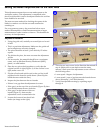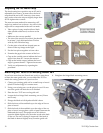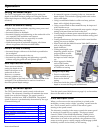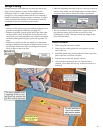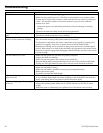
Applications
The TS 55 is capable of performing a wide variety of tasks. The following sections provide information on some of these
tasks. This is intended to be an introduction to the capabilities of the saw, but should not be considered as a comprehensive
list of its capabilities.
Straight-Lining Rough Lumber
Purchasing lumber directly from a saw mill is significantly
less expensive than buying from a home center. However,
part of the reason why the lumber is less expensive is
because it frequently has not been straight-line ripped.
Sawmills have special straight-line ripping tablesaws, but
they charge an extra fee for the service, and straight-lining
on a regular tablesaw is complicated.
The TS 55 can quickly and easily straight-line rough lumber
using the guide rail. Additionally, if the grain of the wood is
diagonal with the cut edge, the TS 55 can be used to re-cut
the lumber on a diagonal to match the natural wood grain
direction or to avoid defects.
Instruction Manual 17
Tips for Successful Straight-Lining
► Use the correct blade for the cut. The Panther ripping
blade will provide the easiest cutting in any hardwood. A
coarse combination blade may be used for softwoods, or
for a finer edge, but it will take more effort to rip the
wood.
► The Panther blade is aggressive enough that you do not
need to fully expose the whole gullet as shown on page
13. For cleaner cuts, expose ½ to a full tooth of the blade
below the wood. The deeper the setting, the easier the
cut will be.
► For a less aggressive, combination blade, you may need
to set the depth so the full gullet is exposed below the
wood.
► Choose the orientation of the guide rail to optimize the
board usage. This may have several different options:
► Align the cut with the natural wood grain orientation.
► Align the cut to avoid defects in the wood.
► Align the cut to maximize board width, while
eliminating curved edges.
► Place the board on sawhorses or elevate it from a work
table so you do not cut into your work table.





